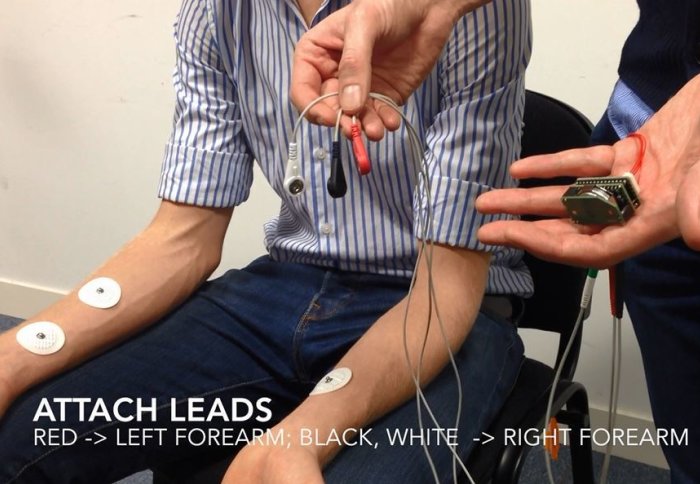Students solve complex equations using own vital signs

A new app by Imperial experts might help increase student engagement in undergraduate lectures.
Professor Danilo Mandic, from Imperial’s Department of Electrical and Electronic Engineering, teaches signal processing courses to undergraduate students, which involve plenty of applied mathematics.
His team conducted a preliminary study to test whether using wearable tech

in the classroom would enrich student intellectual curiosity and engagement, and perhaps even performance, especially in maths-heavy modules.
They developed a small biosignal recording device called iAmp that measured students’ own heart and breathing rates via small electrodes on the wrist. An accompanying computer app gave onscreen instructions on how and when to gather data, before displaying the measurements..
The students applied the taught mathematical concepts of signal estimation to their recorded vital signs and were graded as usual.
Around 450 undergraduate students have been involved so far, spanning the academic years 2014–2015, 2015–2016, and 2016–2017. The researchers gathered feedback on the students’ experiences via Imperial’s student online evaluation system (SOLE).
The body as a unique dataset
At least 85 per cent of the students involved described increased intellectual satisfaction and engagement with the overall approach.
The authors say this could be because students were taught in a physically meaningful and fun way, and that the experience might encourage other educators to enrich theoretical modules in their own classrooms by bringing this technique into the curriculum.
Having a coursework which included real world signals like the ECG, voice and sound files made the course so much more tangible and enjoyable. A student enrolled in the study
As an additional benefit, the authors say the approach could help keep the curriculum current by syncing it to technological and educational developments.
Furthermore, as people and technology become increasingly intertwined, for example with smart phone and smart watch health monitoring, in this way students become prepared to consider the ethics dealing with human subjects.
Co-author Professor Anthony Constantinides, who pioneered the signal processing discipline at Imperial’s Department of Electrical and Electronic Engineering, said engaging students in curiosity-driven learning helped to broaden their perspective on next-generation health care.
(This will) challenge students, engage their curiosity, and give them confidence to be intellectually adventurous. Professor Danilo Mandic Department of Electrical and Electronic Engineering
Professors Mandic and Constantinides said: “We continue to bring research into the classroom, which is now not only feasible but could potentially trigger a paradigm shift in teaching. We hope to inspire students and educators to further enhance the curriculum with relevant real-world examples like wearable health.”
A student on the course said: “Having a coursework which included real world signals like the ECG, voice and sound files made the course so much more tangible and enjoyable."
What’s next?
Professor Mandic said: “We want to develop and apply the tech to other data-heavy subjects like computer science and medicine, or even business. Exploring the ethical and social aspects of our work will challenge students, engage their curiosity, and give them confidence to be intellectually adventurous.”
Professor Mandic’s team will continue to enhance the technique with more data, for example on movement and neural signals. They also noted the

need for ethical and privacy considerations in future studies, as well as developing a protocol when data indicates potential health issues in students.
Overall, the study could help to bring biopresence technology into the classroom more widely at both university and late secondary school level.
The approach is now being adopted at UC Berkeley, USA, and University of Lyon, France.
Information that could identify individual students was not uploaded to a shared space or published, to preserve confidentiality.
“Bringing Wearable Sensors into the Classroom: A Participatory Approach” by Sithan Kanna, Wilhelm von Rosenberg, Valentin Goverdovsky, Anthony G. Constantinides, and Danilo P. Mandic, published 26 April 2018 in IEEE Signal Processing Magazine.
All images credited to Imperial College London/Danilo Mandic
Article text (excluding photos or graphics) © Imperial College London.
Photos and graphics subject to third party copyright used with permission or © Imperial College London.
Reporter
Caroline Brogan
Communications Division